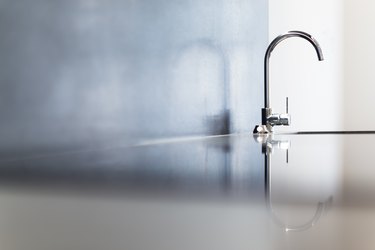
If your bathroom faucet handle is hard to turn or you have a squeaky Delta kitchen faucet, you may need to use some plumber's grease on them. Single-lever faucet issues are usually caused by age and friction, but the good news is that your squeaky Delta kitchen faucet can be easily repaired with a few basic tools and some silicone faucet grease.
Things to Remember
Video of the Day
Just like there are several single-lever faucet issues, there are several brands of faucets, all containing similar but sometimes different parts. For example, a squeaky Delta kitchen faucet isn't assembled exactly like a Moen single handle kitchen faucet. Some faucet brands like Delta sell a kit with many of the tools and parts needed to take apart their faucets, but these kits won't work on other brands.
Video of the Day
When you lubricate a faucet and faucet parts, it's important that you use a silicone-based faucet grease. A faucet grease substitute may contain petroleum, which can react with rubber seals and O-rings, causing them to dry out and corrode. Using a petroleum-based faucet grease substitute can cause the faucet to become even more difficult to operate and result in leaks.
Lubricating a Single-Handle Faucet
Things You'll Need
Silicone-based faucet grease
Allen wrench
Phillips-head screwdriver
Tongue and groove pliers
Needle-nose pliers
Cartridge puller
scrub brush
Step 1: Turn Off the Water
Turn off the water to the faucet using the hot and cold water valves under the sink. If there are no shutoff valves under the sink, you'll need to turn off your main water valve, located where your main water pipe enters the home. Open the faucet to allow water to drain from the pipes.
Step 2: Remove the Faucet Handle
Locate and remove the decorative cap on the faucet handle. Beneath the cap will be either a Phillips-head screw or an Allen screw. Depending on which type of screw you find, use an Allen wrench or Phillips-head screwdriver to loosen the screw. If the screw sticks, you can spray it with penetrating oil to loosen. Lift and remove the faucet handle.
Step 3: Pull Out the Retaining Clip
After removing the handle, you'll find either a retaining clip or a threaded cap. The threaded cap can be removed by turning it counter-clockwise with pliers. Be sure to place the pliers on the cap knurls to prevent scratching. If your faucet has a retaining clip, you can use a pair of needle-nose pliers to pull it out.
Step 4: Remove the Cartridge
Remove the faucet cartridge. Usually, this can be done by hand or with a pair of pliers, but occasionally it will stick and require quite a bit of force to remove. To avoid damaging your faucet and parts, you can use a cartridge pulling tool on a stuck cartridge. Some faucets require brand-specific cartridge pullers, so be sure to check your faucet brand before using one.
Step 5: Clean and Lubricate
Inspect the inside of the faucet stem. If you find mineral deposits, clean them with a scrub brush or a piece of sandpaper. Lubricate all of the threads and faucet parts with silicone-based faucet grease. If there are O-rings on the outside of the stem or cartridge, lubricate these as well. This is also a good time to inspect the faucet parts, including the cartridge, and replace any that appear to be worn.
Step 6: Reassemble the Faucet
Reassemble the faucet by reversing the steps. Wipe up any water around the faucet to make it easier to detect leaks. Turn on the water valves under the sink and test the faucet for leaks and to make sure it's working correctly.